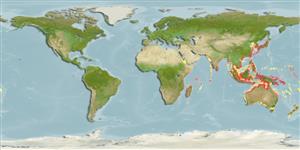Teleostei (teleosts) >
Atheriniformes (Silversides) >
Atherinidae (Silversides) > Atherinomorinae
Etymology: Hypoatherina: Greek, hypo = under + Greek, atherina, the Greek name for the eperlane; 1770 (Ref. 45335).
More on author: Bleeker.
Environment: milieu / climate zone / depth range / distribution range
Ecology
Marine; brackish; pelagic-neritic. Tropical
Indo-West Pacific: widely distributed throughout the southwest Pacific including Java, Borneo, Sumatra, Sulawesi, Viet Nam, Singapore, New Britain, Hermit Island Group, Papua New Guinea, Solomon Islands, Hong Kong and as far as Japan.
Size / Weight / Age
Maturity: Lm ? range ? - ? cm
Max length : 12.0 cm TL male/unsexed; (Ref. 9760)
Dorsal spines (total): 5 - 8; Dorsal soft rays (total): 8 - 10; Anal spines: 1; Anal soft rays: 10 - 13. Free edge of premaxilla densely covered with minute shagreen denticles. Coronoid process of dentary not rounded as in other Hypoatherina species (Ref. 9760). Body covered by large round scales, head is nude except opercle is covered by scales. Silver white colored body (Ref. 41252).
Found near the coast and the surface (Ref. 11230). Occurs in estuaries (Ref. 7050). Probably important as forage fish. Nothing is known of the biology of this fish (Ref. 9760).
Life cycle and mating behavior
Maturities | Reproduction | Spawnings | Egg(s) | Fecundities | Larvae
Oviparous, distinct pairing during breeding (Ref. 205).
Ivantsoff, W. and L.E.L.M. Crowley, 1999. Atherinidae. Silversides (or hardyheads). p. 2113-2139. In K.E. Carpenter and V.H. Niem (eds.) FAO species identification guide for fishery purposes. The living marine resources of the Western Central Pacific. Volume 4. Bony fishes part 2 (Mugilidae to Carangidae). FAO, Rome. (Ref. 9760)
IUCN Red List Status (Ref. 130435)
Threat to humans
Harmless
Human uses
Fisheries: minor commercial
Tools
Special reports
Download XML
Internet sources
Estimates based on models
Preferred temperature (Ref.
123201): 22.1 - 29.1, mean 28.2 °C (based on 1320 cells).
Phylogenetic diversity index (Ref.
82804): PD
50 = 0.5001 [Uniqueness, from 0.5 = low to 2.0 = high].
Bayesian length-weight: a=0.00912 (0.00457 - 0.01819), b=3.09 (2.91 - 3.27), in cm total length, based on LWR estimates for this species & (Sub)family-body (Ref.
93245).
Trophic level (Ref.
69278): 3.2 ±0.32 se; based on food items.
Resilience (Ref.
120179): High, minimum population doubling time less than 15 months (Preliminary K or Fecundity.).
Fishing Vulnerability (Ref.
59153): Low vulnerability (10 of 100).
